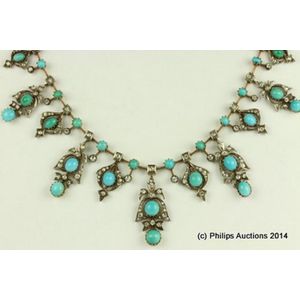Georgian Turquoise & Diamond Drop Brooch
You must be a subscriber, and be logged in to view price and dealer details.
Subscribe Now to view actual auction price for this item
When you subscribe, you have the option of setting the currency in which to display prices to $Au, $US, $NZ or Stg.
- Georgian - As an English stylistic period, Georgian is usually taken to cover the period from George I (1714) to the Regency of Prince George (1811-20), although the period from 1800 to 1830 is sometimes designated as the Regency period. During the Georgian period the great English cabinetmakers and designers such as Chippendale, Hepplewhite, Adam Sheraton etc., were all active.
Therefore there isn't a single 'Georgian style' as such and to say something is 'Georgian', usually means it was made between 1714 and 1830. This assumes we discount George V and George VI, both being from the 20th century.
The styles popular at the time of each reign were:
George I (1714-1727) saw out the last years of the Baroque period.
George II (1727-1760) reigned during the Rococo period.
George III (1760-1820) saw the last gasp of the Rococo, all of the early Neo-Classic 'Adam style' and most of the later neo-Classic 'Regency style'.
George IV (Prince Regent 1820-1830)encompassed the last of the 'Regency' style.
William IV's reign (1830-1837) was something of a no man's land (stylistically) and he wasn't a 'George' anyway. He covered the last glimmerings of 'Regency' and the start of the 'Victorian' style.
This item has been included into following indexes:
Visually similar items

A stunning antique turquoise and diamond fringe necklace. Silver on rose gold, Victorian, circa 1890, designed as a beautiful graduated necklace of drops, each featuring fine quality cabochon oval and round turquoise, claw set, framed and flanked by grain

An Edwardian 9ct. gold pendant/brooch, the frame decorated with small flowers and ribbons profusely set with seed pearls and a central turquoise with a conforming turquoise suspended from base

9ct white gold, diamond, sapphire & topaz necklace, 37 bezel set brilliant cut diamonds TDW 1,11ct G-H/SI, 108 blue sapphires, 18 yellow sapphire and 24 briolette drop cut blue topaz.

An Art Nouveau style emerald and diamond pendant necklace with gold cable link chain and bolt-ring clasp
